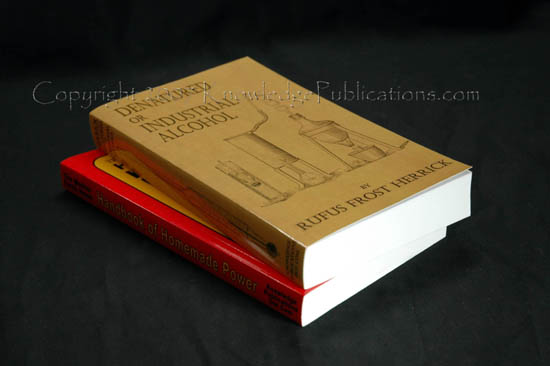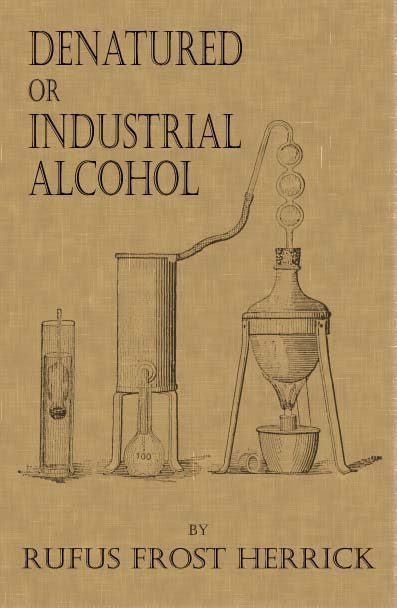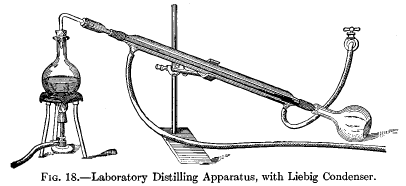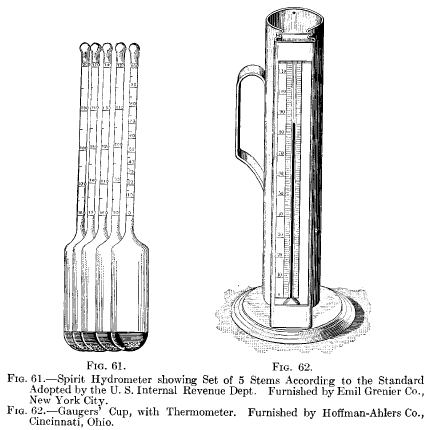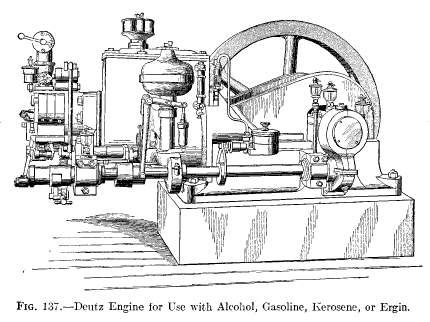Using Alcohol for Fuel
Denatured (and) Industrial Alcohol $29.95
Every Single Way of Making Alcohol on an Industrial Scale—or small scale. 516 Pages of knowledge that covers fermentation, the organisms, source material, mashes, crops to use, yield, formulas, distillation, byproducts, heat measurement, usage in engines and much more. The book covers the usage of alcohol for cooking, heating and illumination, just to name a few. It even has details on converting sawdust and other organic material to a form that can be digested by alcohol yeasts to make ETHYL Alcohol. Yes!—Ethanol from sawdust, dead trees, newspaper, cellulose etc… Making alcohol will be an important part of a hydrogen generation system that Roy McAlister and I will be detailing in a future DVD. You will be able to make H2 from alcohol that is made to hydrogen boost turbines or methane. With this book, we made alcohol, distilled it and burned it in 7 days! NO, it is not illegal. It is illegal in most places to distill alcohol for human consumption. You do NOT drink DE-natured alcohol. If you are going to seriously distill alcohol, it is easy to get a still permit from the ATF.
Denatured and Industrial Alcohol
“A TREATISE ON THE HISTORY, MANUFACTURE, COMPOSITION, USES, AND POSSIBILITIES OF INDUSTRIAL ALCOHOL IN THE VARIOUS COUNTRIES PERMITTING ITS USE,AND THE LAWS AND REGULATIONS GOVERNING THE SAME, INCLUDING THE UNITED STATES. WITH CONCISE TABLES, METHODS, AND NOTES FOR THE USE OF THE ENGINEER, CHEMIST, MANUFACTURERS OF ALCOHOL AND ALCOHOL MAKING AND USING APPARATUS, INCLUDING ALCOHOL MOTORS, ENGINES, ILLUMINATING LAMPS, AND HEATING AND COOKING STOVES”
THE enactment of legislation by Congress on June 7, 1906 (permitting the general use of tax-free domestic alcohol, after it has been suitably denatured, for industrial purposes and for light, heat, and power) immediately created a wide-spread interest and inquiry throughout the United States as to the facts relating to the whole matter.
The scarcity of literature treating the subject of Denatured or Industrial Alcohol was so great that there were practically no books concerning it. This book was therefore prepared. The author had the honor to represent the American Chemical Society and the Society of Chemical Industry, through their New England sections, in favor of Denatured Alcohol, at the so-called "Free Alcohol" Congressional hearings, held in Washington, D. C., February–March, 1896, on the matter of repealing the internal-revenue tax on domestic alcohol after it had been suitably denatured. The testimony given at these hearings was from a great variety of sources and possessed a highly educational value and interesting character, many important abstracts from such testimony are given in this book under their appropriate subjects.
There is also a very complete list, on page 494, from the Patent Review, New York, of all the important patents relating to improvements in the manufacture of alcohol and in alcohol-distilling apparatus for the twenty years prior to the books original publication.
CHAPTER ONE: COMPOSITION, HISTORY, AND USE OF DENATURED ALCOHOL
Composition of Denatured Alcohol in Foreign Countries
Distilled Spirits Defined
History of Denatured Alcohol in Foreign Countries
History of Tax-free Alcohol in the United States
Use of Denatured or Industrial Alcohol in Foreign Countries
Use of Industrial Alcohol in Cuba
Use of Industrial Alcohol in the United States
CHAPTER TWO: THE MANUFACTURE OF ALCOHOL
The Raw Materials Used
The Preparation of the Raw Materials for Fermentation
The Composition of the Raw Materials Used
Malting
The Fermentation
Theoretical versus Practical Yields of Alcohol
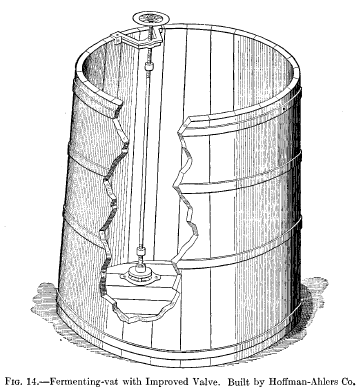
The author defines fermentation as the change induced in organic matter through the agency, direct or indirect, of micro-organisms or their enzymes. The fermenting-vats used vary in size according to circumstances. In Fig. 14, page 34, is shown the improved manner of operating the valve in the bottom, which discharges the mash.
The Micro-organisms
The Use of Moulds in Saccharification
The Fermentation Period
Wild and "Disease" Yeasts
The Control of the Fermentation Operations
(a) The Control of the Yeast
(b) The Estimation of the Fermentable Matter
(c) The Estimation of the Yield in Alcohol from the Fermented Mash
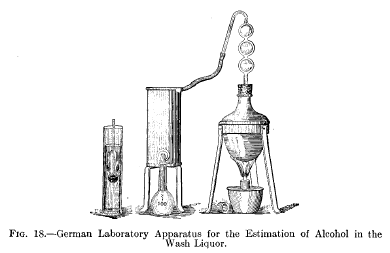
To prepare absolute alcohol, quicklime, anhydrous copper sulphate, and metallic sodium are employed. For the distillation, in determining the amount of alcohol formed in a fermentation at least a half-liter should be used, and larger amounts, up to 2 or 3 liters, are probably preferable.
The distillation is carried out in a glass or metal flask, and the alcoholic vapors are condensed in a tube, or worm, surrounded by cold running water, and collected in a receiver. A German laboratory apparatus for this purpose is shown in Fig. 18. A specially made small alcohol hydrometer and jar is shown at the left of this cut. The heat is supplied by burning denatured alcohol.
Practically all the alcohol will be contained in an amount of the distillate equal to two fifths of the alcoholic solution taken. This is then accurately made up to the original volume and the specific gravity determined by the pycnometer.
The Conditions Favorable to Alcoholic Fermentation
CHAPTER III. THE DISTILLATION AND RECTIFICATION OF ALCOHOL
Theory of Vapor Pressure and Boiling-point
Boiling-points of Mixtures of Ethyl and Methyl Alcohol
Boiling-points of Mixtures of Ethyl Alcohol and Water
Theory of Distillation
Simple Distillation
Constant Boiling Mixtures
Theory of Fractional Distillation
Fig. 18 shows an apparatus that consists of a glass flask (or a retort) in which a liquid or liquid mixture is boiled and the condenser into which the vapor thus formed is conducted and by which it is recondensed, the distillate being collected in the receiving-flask.
This form of condenser consists of two tubes between which a current of cold water flows in an upward direction or opposite to the flow of the distillate. The inner tube of this condenser as well as the outer is sometimes made of glass and in some instances of metal.
Theory of Compound Distillation
Dephlegmation
The Efficiency of Fractional Distillation
The Extraction of the Alcohol by Distillation
The Rectification of the Alcohol
History of the Distillation of Alcohol
Commercial Apparatus for the Distillation of Alcohol
American Alcohol-distilling Apparatus
CHAPTER FOUR: ALCOHOLOMETRY
The Determination of Alcohol by the Alcoholometer
The Determination of Alcohol by Distillation
The Alcohol Tables Adopted by the A. 0. A. C.
The U. S. Proof Gallon, Wine Gallon, and Taxable Gallon
The U. S. Alcohol Tables for the Control of Denatured Alcohol
In testing spirits for their alcoholic strength in per cents of proof by tables given on pages 143-145, a gauger's cup, shown in Fig. 62, p. 142, and alcohol hydrometers, shown in Fig. 61, p. 142, are used. Proof or 100 will be indicated on the hydrometer when the temperature of the spirit is at 60° F. Tables for correction of temperature when it varies from 60° F. are supplied in this manual.
The gauger's cup is filled with the spirit to be tested according to the directions in this manual, and the hydrometer is carefully placed therein and the degree or per cent proof is read from the scale on the stem at the surface of the spirits according to these published directions. A complete set of five stems according to the Standard of the U. S. Internal Revenue is shown in Fig. 61, ranging from water marked 0 to absolute alcohol marked 200.
The Detection and Determination of Ethyl and Methyl Alcohols in Mixtures by the Immersion Refractometer
The Determination of Methyl Alcohol in Denatured Alcohol by the Immersion Refractometer
Tests for the Detection of Acetone, Methyl Alcohol, and Ethyl Alcohol
The Denatured Alcohol Motor for Laboratory Power Purposes
CHAPTER FIVE: THE COST OF ALCOHOL AND OF ALCOHOL-DISTILLING PLANTS
Cost of Alcohol from Different Raw Materials
By-products in the Distillation of Alcohol
Fusel-oil
The Composition of Fusel-oil
The Value of the Slop or Spent Wash
The Manufacture of Ethyl Alcohol from Sawdust
Ethyl Chloride as a Refrigerant
Plan of Distillery for Distilling Alcohol from Corn
Cost of Buildings for Alcohol-distilling Plants
Cost of Alcohol-distilling Plants
Cost of Commercial Wood Alcohol (Methyl Alcohol)
The Determination of Alcohol by the Alcoholometer
Combo Deal - Denatured or Industrial Alcohol and Handbook of Homemade Power $44.95
The Incandescent Mantle for the Alcohol Lamp
The Incandescent Alcohol Lamp

In describing the Phoebus Incandescent Alcohol Lamp, of which a cut is shown in Fig. 90, it may be said that the manipulation of this lamp is practically the same as those heretofore described in this chapter. The lamp is lighted at A by a match. It is extinguished by closing the screw vapor-valve B. In filling the lamp the alcohol is put in at the orifice C. D is the regulator. For a table lamp for reading purposes a shade is placed upon the support E. The small rubber bulb shown, when compressed, forces a little alcohol into the lighting chamber A. This bulb is readily detachable, being provided with a metallic connection. The lamp is here shown without the base in order to show the details. Any design and material is supplied for the base by the manufacturers.
The Alcohol Illuminated-sign Lamp
The German Incandescent Alcohol Street Lights
Cost of Lighting by Kerosene
The Incandescent Welsbach Gas Light
Acetylene as a Source of Illumination
The Electric Incandescent and Arc Light
Alcohol Compared to other Sources of Illumination
CHAPTER SEVEN: THE FUEL VALUE OF ALCOHOL COMPARED WITH THE OTHER USUAL LIQUID FUELS
The Williams Bomb Calorimeter
The Thermal Efficiency of a Fuel
The Fuel Value of Denatured Alcohol
Calculations of the Volume of Air Necessary for Complete Combustion of Alcohol, Gasoline, Kerosene, and Crude Petroleum
Ratio of Prices of Various Fuels
Ratio of Vitiation of the Atmosphere by Combustion of these Fuels
Table of the Calorific Value of the Usual Liquid Fuels
Alcohol Heating and Cooking Apparatus and Stoves
CHAPTER EIGHT: ALCOHOL AS A SOURCE OF POWER
The Deutz Alcohol-engine
Shown in Fig. 137, p. 275, is an illustration of the Deutz alcohol engine, type E-12, of 20 horse-power. The original Otto or Deutz engines were built in Germany for a period of about forty years, the Otto engines types E-10, M-10, and E-12 were single-acting explosive engines. The cylinder being closed at one end, a mixture of air and gasoline, kercsene or alcohol vapor was exploded in the cylinder, the resulting pressure moved a piston which transmitted power through the connecting-rod and crank to the fly-wheel shaft.
The Deutz Alcohol-motor or Portable Engine
American Alcohol-engines
The Alcohol-motor for the Automobile
The Diesel Engine
The Kerosene-oil Engine
The Gasoline-engine and its Adaptation to Alcohol
Comparison of the Economy of the Steam-engine with Other Types of Engines
The Gas-engine Compared with Other Types of Engines
Outline of the Methods Used in Testing Internal-combustion Engines
CHAPTER NINE: LAWS AND REGULATIONS FOR DENATURED ALCOHOL
In Foreign Countries
Law for Denatured Alcohol in the United States
Cost of Denaturing Alcohol in Foreign Countries
Cost of Denaturing Alcohol in the United States
Properties of Denaturing Materials
Special Denaturing Methods in Foreign Countries
Tests Prescribed by Foreign Countries for the Denaturing Materials Used
Tests Prescribed by the United States for the Denaturing Materials Used
Completely Denatured Alcohol and Specially Denatured Alcohol in the United States
Recovery of Denatured Alcohol is Permitted by the United States Regulations
Spirit Varnishes
CHAPTER TEN: DENATURED ALCOHOL IN THE UNITED STATES
The Impracticability of Purifying Denatured Alcohol
The Possibilities of Industrial Alcohol in the United States
APPENDIX
THE UNITED STATES REGULATIONS AND INSTRUCTIONS CONCERNING THE DENATURATION OF ALCOHOL AND THE HANDLING AND USE OF SAME UNDER THE ACT OF CONGRESS OF JUNE 7, 1906
AMENDMENTS TO THE ACT OF CONGRESS OF JUNE 7, 1906
REPORT OF THE BRITISH DEPARTMENTAL COMMITTEE ON INDUSTRIAL ALCOHOL, PRESENTED TO BOTH HOUSES OF PARLIAMENT BY COMMAND OF HIS MAJESTY, MARCH 23d, 1905
APPENDICES FROM MINUTES OF EVIDENCE TAKEN BEFORE THE BRITISH DEPARTMENTAL COMMITTEE ON INDUSTRIAL ALCOHOL, PRESENTED TO BOTH HOUSES OF PARLIAMENT BY COMMAND OF HIS MAJESTY
ABSTRACT FROM BRITISH REVENUE ACT, 1906, as TO SPIRITS USED IN ART, MANUFACTURE, ETC., AND SUPPLEMENTAL AMENDMENTS OF THE SPIRITS ACT
BIBLIOGRAPHY OF DENATURED ALCOHOL AND BOOKS OF REFERENCE
LIST OF PATENTS RELATING TO THE MANUFACTURE OF ALCOHOL AND ALCOHOL-DISTILLING APPARATUS
GENERAL INDEX
INDEX TO U. S. REGULATIONS AND INSTRUCTIONS
INDEX TO REPORT OF THE BRITISH DEPARTMENTAL COMMITTEE
INDEX TO APPENDICES FROM MINUTES OF EVIDENCE TAKEN BEFORE THE BRITISH DEPARTMENTAL COMMITTEE
Denatured (and) Industrial Alcohol $29.95
Every Single Way of Making Alcohol on an Industrial Scale—or small scale. 516 Pages of knowledge that covers fermentation, the organisms, source material, mashes, crops to use, yield, formulas, distillation, byproducts, heat measurement, usage in engines and much more. The book covers the usage of alcohol for cooking, heating and illumination, just to name a few. It even has details on converting sawdust and other organic material to a form that can be digested by alcohol yeasts to make ETHYL Alcohol. Yes!—Ethanol from sawdust, dead trees, newspaper, cellulose etc… Making alcohol will be an important part of a hydrogen generation system that Roy McAlister and I will be detailing in a future DVD. You will be able to make H2 from alcohol that is made to hydrogen boost turbines or methane. With this book, we made alcohol, distilled it and burned it in 7 days! NO, it is not illegal. It is illegal in most places to distill alcohol for human consumption. You do NOT drink DE-natured alcohol. If you are going to seriously distill alcohol, it is easy to get a still permit from the ATF.

